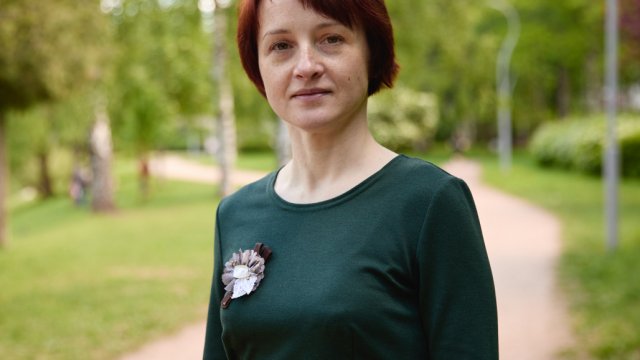Specialists from the N. Laverov Federal Center for Integrated Arctic Research of the Urals Department of RAS (Arkhangelsk, Russia) presented their find of a migratory species of butterflies on the islands of the High Arctic: two individuals of red-black large tortoiseshells were discovered at Cape Zhelaniya (near the northern tip of Novaya Zemlya archipelago). With its range in Siberia and the Urals, the butterfly was earlier spotted in Yakutia. Scientists attribute the expansion of the range of large tortoiseshells to the effect of climate warming on the propagation of this species. Thus, northward expansion of other southern animal species cannot be ruled out
Intensive agricultural development, deforestation and the improvement of urban green spaces sometimes lead to the destruction of natural habitats of insects and affect their migration and the dynamics of their activity. However, climate change is also an essential factor in understanding the mechanism of adaptation of lepidopterans, especially those penetrating from the southern regions to the high latitudes of the Earth.
The staff from the Federal Center for Integrated Arctic Research and the Russian Arctic National Park (Arkhangelsk) was able to detect migration of red-black large tortoiseshell butterflies to the Northern Island of the Novaya Zemlya archipelago. By reconstructing the climate situation and weather conditions, scientists traced the causes of long-range migrations and mass reproduction of the corresponding species in the mainland. Biologists from Arkhangelsk also analyzed all finds of migratory butterflies on the islands of the Arctic region: they turned out to be ordinary and the most common species but were found at such a distant range only twice in the history of observation in nature. Findings from the study are recently presented in the NOTA LEPIDOPTEROLOGICA (VOL. 44, 2021).
Ivan Nikolayevich Bolotov – Doctor of Biological Sciences, Corresponding Member of the Russian Academy of Sciences, Director of the N. Laverov Federal Center for Integrated Arctic Research of the Urals Department of RAS (Arkhangelsk), head of the laboratory of molecular ecology and phylogenetics of the Northern (Arctic) Federal University
Ivan Nikolayevich Bolotov – Doctor of Biological Sciences, Corresponding Member of the Russian Academy of Sciences, Director of the N. Laverov Federal Center for Integrated Arctic Research of the Urals Department of RAS (Arkhangelsk), head of the laboratory of molecular ecology and phylogenetics of the Northern (Arctic) Federal University (Arkhangelsk), explained how migratory species of southern butterflies end up on the islands of Arctic archipelagoes and why this unique event is so significant for researchers and is viewed in the scientific community as a highly sensitive indicator of climate change.
Recently butterflies were spotted in Arctic latitudes, which is explained by warmer weather in these regions, favorable breeding conditions, and expansion of ornamental landscaping in large cities of Russia. At the same time, there are butterflies that are adapted to survive in cold regions: Siberia, Chukotka, Kamchatka, and even on some Arctic islands. Nevertheless, the phenomenon of southern migratory butterflies appearing in the Arctic was surprising.
Ivan Bolotov explained in accessible terms how this phenomenon helps to understand to issues related to the patterns and routes of global animal migrations:
“There are several butterfly species whose range is confined to the Arctic zone. These are particular species that are well adapted to living in extremely cold climates. Well-known Russian scientists, RAS Academician Yuri Ivanovich Chernov and Doctor of Sciences Andrei Tatarinov prepared an exhaustive review of daily butterflies in the fauna of the Arctic and examined the adaptation of such species to tundra and Arctic deserts. We are talking about the so-called migratory lepidopterans, the main range of which is located further away to the south. For example, the painted lady is a widely known migratory species. In winter, this species breeds in Africa. Then it migrates in the spring to Southern and Central Europe and some summers it can reach Northern Europe and the Arctic islands. Not only can it breed successfully in the taiga zone but its offspring is capable of a southward migrating in the fall along northerly winds that prevail during this period. However, painted ladies die in the Arctic after arriving there: the summer season is too short and their caterpillars have no plants to feed on. In addition to the painted lady, a number of butterfly species are capable of long migrations and can occasionally reach the Arctic archipelagoes (see Fig. 1).”
Fig. 1. Finds of migratory butterfly species (shown as pictures) on islands in the High Arctic. Red stars show migratory butterfly discovery locations: 1 – Northern Island, Novaya Zemlya; 2 – Vaygach Island; 3 – Dolgy Island; 4 – Kolguyev Island; 5 – Svalbard; 6 – South Greenland; 7 – Central Greenland. Pink stars show areas of Siberia where an outbreak of mass reproduction of red-black large tortoiseshells was discovered in 2019-2020: 8 – Yakutsk; 9 – Tiksi. Hatched circles show the tentative territories of large-scale expansion of Vanessa polychloros in Eastern Siberia in 2020 (A1) and the Polar Urals region where these butterflies were found frequently since the 1970s (A2).
According to the scientist, “the study of butterfly migrations to the Arctic allows us to find out how far north the species can become settled. Furthermore, finds of southern butterfly species on Arctic islands are evidence of a warming climate on the mainland. Accordingly, butterflies can be seen as sensitive bioindicators of global climate change. Sightings of migratory butterflies in the Arctic archipelagoes are extremely rare and each such find is a unique and significant event from a pure science standpoint, deserving of a dedicated comprehensive analysis and publication.”
What butterfly species was spotted by your team and in which way is it unique? How could they have ended up there?
“The staff of the Russian Arctic National Park discovered individuals of red-black large tortoiseshell at the northern tip of Novaya Zemlya (Cape Zhelaniya) in 2020. Two live butterflies were spotted, one in July and another one in August. We were able to photograph the August visitor (see Fig. 2).
Black-red large tortoiseshell at the northern tip of Novaya Zemlya. The upper picture A shows the general view of the Cape Zhelaniya Research Station at the Russian Arctic National Park where the butterflies were encountered (photo by Stefan Graupner).
The station is located near the northern tip of the North Island, in the Arctic desert zone. A low mountain range covered with glaciers and perennial snow can be seen in the background. The lower picture B shows a butterfly that was spotted near the station on August 23, 2020.
Sometimes butterflies are brought accidentally to remote islands with ships or aircraft. However, ship calls at Cape Zhelaniya were few and cannot be correlated to butterfly discovery dates. Same for the only helicopter flight from Naryan-Mar. Therefore, we ruled out the possibility of human introduction of butterflies and consider these finds to represent natural migration,” the scientist reported.
Where is this species usually distributed?
“Vanessa polychloros is quite abundant in Siberia and the Urals. East of the Urals, outbreaks of its mass reproduction are not uncommon: they were previously recorded by scientists in 1958, 1967-1968, 1994, and 2002. Meanwhile, the species has remained rare in the European part of Russia and European countries, at least since the 1880s. In 2009-2010, a large-scale expansion of Vanessa polychloros to Western and Northern Europe began. This expansion was associated with an increase in the species’ abundance in Siberia, the Urals and to the east of the European subcontinent. Interestingly, such an extension of the range was predicted by European scientists whose earlier simulations showed that climate warming will affect the range of Vanessa polychloros. Their forecast model was presented in a book, Climatic Risk Atlas of European Butterflies, published in 2008, a year before the expansion of the butterfly’s range to Europe. Thus, large tortoiseshell can be considered as a highly sensitive bioindicator of climate change. In 2019-2020. an outbreak of mass reproduction of the large tortoiseshell was recorded in Eastern Siberia. This phenomenon has been repeatedly covered in regional media and social networks. Our specialists in 2020 observed a massive flight of these butterflies in the Yakutsk region. Moreover, butterflies were common in rocky tundras near the town of Tiksi, on the coast of Laptev Sea (see Fig. 3).
Black-red large tortoiseshell in the Tiksi region, Laptev Sea coast, Yakutia. The top picture shows a general view of the landscape in the Tiksi area (Photo: Olga Aksenova)
As Ivan Bolotov emphasized, “when writing the article, we reviewed all the previously known finds of migratory species of day butterflies on islands of the High Arctic. That said, we did not include data on island territories lying further south, such as Iceland and Faroe Islands. Migratory butterflies are encountered there amazingly frequently. Our final list includes only 15 unique butterfly finds on islands such as Svalbard, Kolguyev, Vaygach, Dolgy, Novaya Zemlya and Greenland. Studies have shown that six species of migratory day butterflies can reach the islands of the High Arctic (see Fig. 1 above). All of them are ordinary and widespread species such as painted lady, admiral, black-red large tortoiseshell, mourning cloak, mustard white and thorn butterfly. The world’s farthest reach of migratory butterflies to the North was recorded on the island of Svalbard in 1978. They were painted ladies. Our discovery of large tortoiseshells on Novaya Zemlya ranks second in terms of range. Moreover, it is the northernmost encounter of migratory large tortoiseshells ever recorded by scientists.”
Does this sudden migration of butterflies pose a threat to the already innumerous Arctic fauna (is it likely that females laid eggs during their stopover from which larvae will hatch and damage scarce Arctic vegetation)?
“Of course, migratory butterflies pose no threat to Arctic ecosystems. Interestingly, butterfly finds on the islands of the Arctic Ocean are always associated with mass reproduction of the corresponding species on some mainland territory. At the same time, outbreaks of mass reproduction of butterflies and subsequent migrations to the North usually go hand in hand with favorable climatic conditions. The climate is getting warmer – so mass reproduction outbreaks are getting more frequent and migrations, more intense.
Whether migrating butterflies can gain foothold in the Arctic in the distant future is unclear. The key question is how much contemporary warming of the climate will be sustainable. If the long-term forecasts on hand are correct and warming will increase further, the southern boundary of the Arctic will shift northward. Permafrost will melt, and forests will steadily approach the coast of the Arctic Ocean. More southern species of animals, including butterflies, will follow this northward movement of boreal ecosystems. Relatively recently (4-6 thousand years ago) there was such a warm period, known as the Holocene optimum. Back then, forest ecosystems flourished in the today’s tundra zone. Broad-leaved trees grew in the European North, for example, in Karelia, the Arkhangelsk region and the Komi Republic. As you can see, modern warming is still a far cry from the Holocene optimum. Centuries are needed to significantly shift the boundaries of natural zones, although scientists are already able to see the gradual advance of the treeline in the mountains and in the Arctic over the last three decades,” Ivan Bolotov explained his point.
As a rule, during faunal studies, entomologists search for insects using different techniques, but in this case, it was not difficult. For, according to Bolotov, “large tortoiseshells are large and easily discernible butterflies, especially in the tundra zone. Therefore, they are not difficult to detect. To confirm the fact of the find, at least one collected specimen or a high-quality photograph suitable for identifying the butterfly is required. Butterflies were caught using an entomological sweep-net.”
The next step involves reconstruction of climate data and air currents based on public data available from global Internet portals. Scientists from Arkhangelsk used the Ventusky web application (https://www.ventusky.com; InMeteo, Pilsen, Czech Republic), which allowed them chart the flow of air masses at any given time and date.
РEarlier, researchers from the N. Laverov Federal Center for Integrated Arctic Research of the Urals Department of RAS had undertaken an expedition to Yakutia which led them to a discovery of a population of large tortoiseshells.
What explains the appearance and outbreak of butterfly reproduction? Does their habitat (in Yakutia and the Arctic) display any shared features or are there similar causes of migration?
“We believe that the mass reproduction of large tortoiseshells in Siberia and their large-scale migrations to the coast of the Arctic Ocean and to the Arctic islands in 2019-2020 were due to climate warming. For instance, the summer season of 2020 was unusually warm. Suffice it to note that the average air temperature in July was the third highest since the start of global climate measurements in 1880, and the August reading was second highest. Such hot weather favored the development of insects and their flights with the help of heated air masses. As I said, the appearance of migratory species in the Arctic is always associated with their mass reproduction on the mainland. As butterflies multiply, they often begin to migrate northward, and the probability that they will be brought to the Arctic islands increases sharply,” Ivan Bolotov expressed his opinion and drew attention to a curious circumstance: “It is interesting that the study on butterflies at hand owes itself more to a fortunate sequence of random events rather than to results of purposeful scientific search. It is relevant that we worked in Yakutia under a grant of the Russian Scientific Foundation, “Impact of landscape and zonal conditions and anthropogenic impacts on biodiversity and freshwater ecosystems of the Arctic (on the scale of geological and historical time)” (Project No. 19-14-00066, headed by Professor M.V. Vinarsky, St. Petersburg State University). This project purported to study the taxonomy and phylogeography of freshwater animals in the Arctic zone. Field work was mainly carried out in the Tiksi area. In addition, materials were collected near Yakutsk. In both areas, butterflies were collected by the expedition along the way as an addition to the large collection of aquatic species from rivers and lakes of the region. At the time when these studies were performed in Eastern Siberia, we were not yet aware of butterfly finds on Novaya Zemlya by the staff of the Russian Arctic National Park. This became known only in the fall, when our colleagues returned to the mainland. And then it became clear that the arrival of large tortoiseshell at Novaya Zemlya is associated with their mass reproduction in Eastern Siberia and expansion to the coast of the Arctic Ocean, which we observed in Yakutia. With pieces of the puzzle fitting together, we only had to reconstruct air flows over the ocean during the periods of butterfly encounters on Novaya Zemlya.”
What are the original mainland areas and what natural causes of migration did you identify? What is the key takeaway for understanding butterfly migration?
“As a result, we found that the first sighting of large tortoiseshell on Novaya Zemlya in July was associated with a powerful air transfer from the territory of the Yamal Peninsula, when a high-speed mass of warm air approached Cape Zhelaniya from the south (see Fig. 4). In August, a warm air mass came to the archipelago from the Taimyr Peninsula in the east. Thus, butterflies crossed the 580-650 km wide water barrier with prevailing air flows. We can say that insects use warm air flows as a kind of “air taxi.” What they have is to keep the right altitude, letting the air jet take them over the ocean to the island territories. The duration of migration in this case directly depends on the speed of air flow,” the director of the Federal Center for Integrated Arctic Research summed up.
Fig. 4. A reconstruction of prevailing air flows and air temperatures in northern Siberia and surrounding the Arctic Ocean for dates corresponding to the migrations of the black-red large tortoiseshell to the Arctic in July (A) and August (B) 2020. White arrows show airmass transfer directions. Red circles show the most likely mainland origins of migratory species. Red arrows show likely migration paths of butterflies to the Arctic with flows of warm air.
Notably, in the same volume of the journal NOTA LEPIDOPTEROLOGICA (VOL. 44, 2021) that presented the findings of the work of experts from the Federal Center for Integrated Arctic Research, a paper was published in parallel by another group of scientists describing the migration of another species of butterflies (gray larch-tree toitrix) to Wiese Island.
What does that tell us? Should this be considered as evidence that warming in the Arctic increases the susceptibility of polar ecosystem species to invasion by more southern species?
“Yes, it was somewhat unexpected. The article was published in the journal immediately after our work. Wiese Island is much further away – 340 km from the northern tip of Novaya Zemlya and 540 km from the mainland coast. It is great luck to discover migrant toitrixes at an island that far away. This remarkable discovery already shows a trend: the summer of 2020 was so warm in mainland Siberia that conditions favorable to mass reproduction and migration of different butterfly species occurred. Two species have been recorded, but there could be more.
However, as in the case of Vanessa polychloros, the sustainable existence of a toitrix in the Arctic is impossible at this stage, so migrating individuals are flying toward their sure death. Biogeographers call such fringe areas of the range a zone of sterile eviction – butterflies can fly there but will fail to reproduce due to unfavorable conditions. However, these facts show how quickly the fauna of distant islands can change with further warming of the climate. It turns out that ocean stretches up to 500-700 km across are not a significant barrier for a number of butterfly species, including smaller ones such as toitrixes.
Based on this data, it can be assumed that migratory butterflies can reach other Arctic archipelagoes, such as Severnaya Zemlya or Novosibirsk Islands. No migratory species have ever been recorded there. Most likely, the reason is that there is no one to record such migrations. Let us hoped that in the future research stations will also spring up on these remote archipelagoes, such as the Cape Zhelaniya station in the Russian Arctic National Park at Novaya Zemlya. Then we will have the opportunity to more deeply understand the patterns of insect migrations to the High Arctic and the relation of these processes to global climate change,” Ivan Bolotov commented on this scientific fact.
Thus, the discovered specimens of Lepidoptera could have been brought into the Arctic by air masses, and trends underlying the shift of the species’ range correlate with seasonal weather conditions and global climate trends.


























